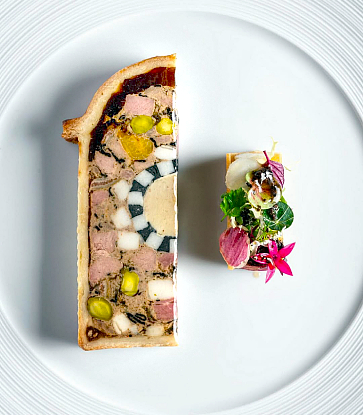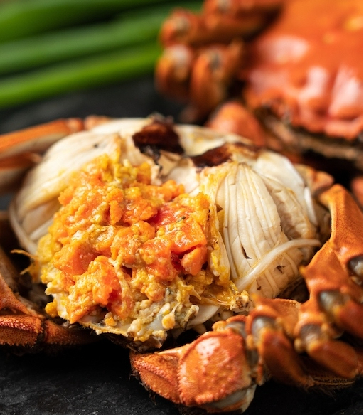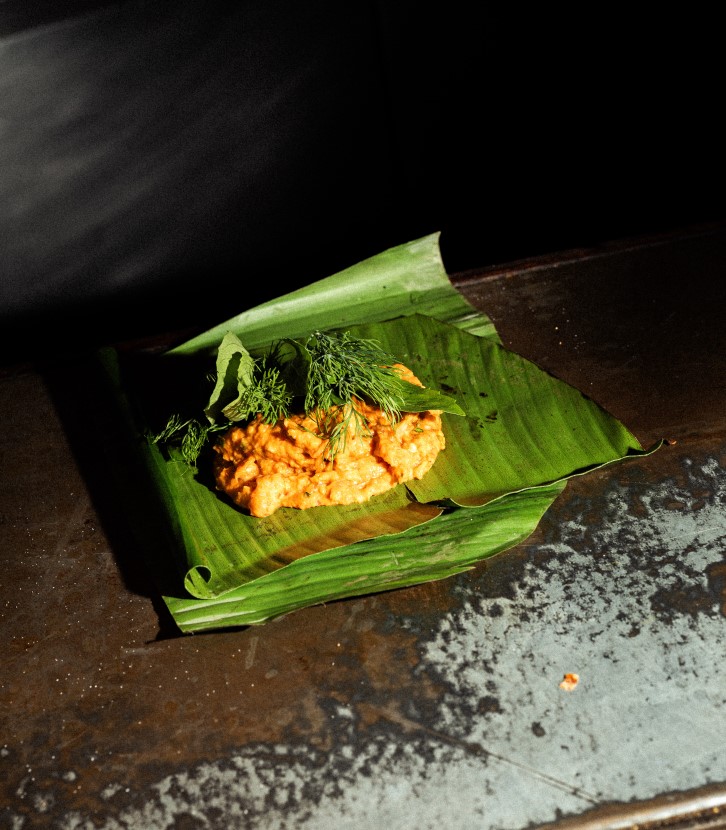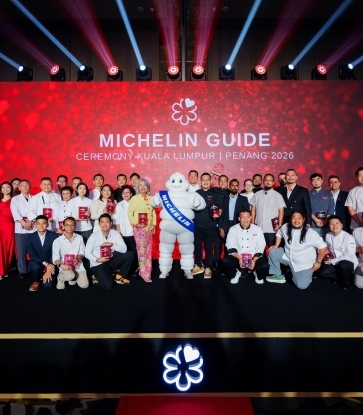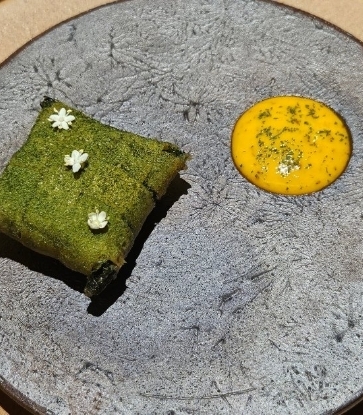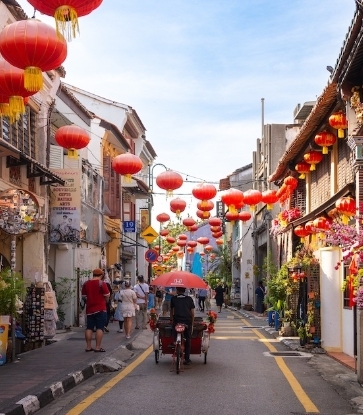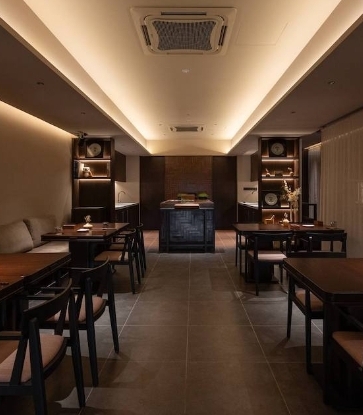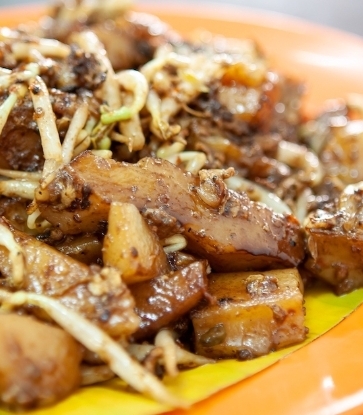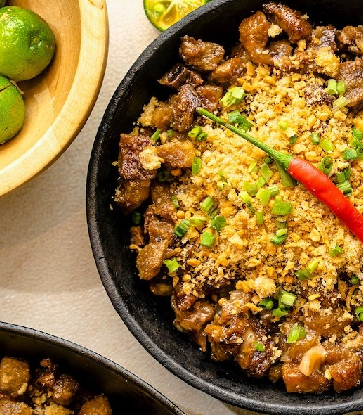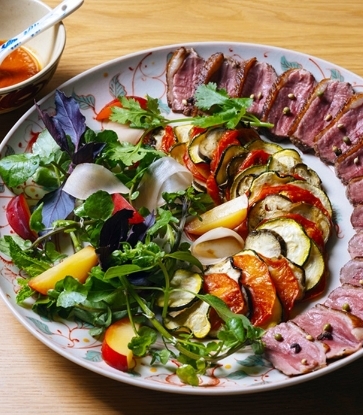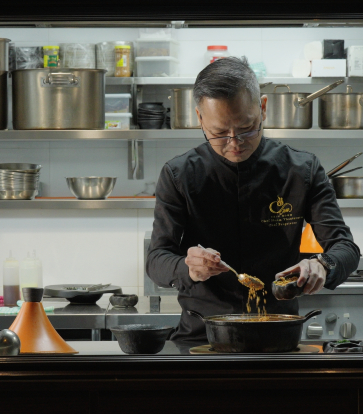The iconic Penang asam laksa is an exuberant manifestation of all that is fresh, vibrant, and exciting about the island’s street food culture. In Malaysia, the culinary term "laksa" generally refers to a rice noodle dish smothered with an assertively flavoured broth, ranging from Malacca’s Nyonya laksa with its spicy shrimp-based potage, enriched with coconut milk, to the mysterious Sarawak laksa, with its intoxicating chicken brew, suffused with dark-hued, coriander-inflected Bornean spices.

One of the best versions of asam laksa in Penang can be found at the popular MICHELIN Bib Gourmand-listed Penang Road Famous Laksa, run by owner-chef, Leow Woo Taid, 40, together with his mother, Madam Nguang Siik Hee, 77. Each morning, a queue forms in front of the shop long before it opens, as the asam laksa’s distinctive, deliciously seductive aroma wafts through the air.
Here, Leow tells us more about Penang Road Famous Laksa’s story and his vision for the future.

You’re the third generation of your family to run Penang Road Famous Laksa, after your grandmother, Teh Siew Heoh, and later your mother, Nguang Siik Hee. What motivated you to take over the family business?
My father, Leow Boon Hock, was actually the one who first started the asam laksa stall at Joo Hooi Café, down this very same street back in 1970. But he subsequently decided to move to Brunei for better prospects sometime in the mid-70s, so my grandmother decided to take over the running of the stall. She was very popular and the Joo Hooi Café asam laksa stall became synonymous with her.
My parents met whilst they were working together in Brunei. After marriage, they resettled in my mother’s hometown, Sibu, Sarawak, in 1979. I was born in 1985, the youngest of three siblings, and the only son.
During the Asian financial crisis of 1997, my father decided to return to Penang by himself and opted to run an asam laksa stall in Bayan Baru, whilst my grandmother continued with the original stall at Joo Hooi Café. However, due to my grandmother’s failing health in 2006, my father decided to return to the Joo Hooi Café stall.
We had to move out from our long-time Joo Hooi Café location to our present one here in December 2015 when the new café owner doubled the rent. It was a big challenge for us initially, as many of our customers were not aware of our new location.
When my father passed away in 2018, I decided to take the reins to perpetuate his legacy.

What do you think sets your asam laksa apart from others in the market?
We use three types of fish for our laksa gravy: sardine, tua bak (wolf herring), and tenggiri (narrow-barred Spanish mackerel). We do not use kembong (Indian Mackerel) because of its very strong fishy taste which some diners find overwhelming.
We also do not blanch our onions and pineapples with the hot broth, but instead, will only garnish our laksa with freshly sliced onions and pineapples just before serving to maintain the purity of our laksa gravy. The common practice among asam laksa hawkers is to repeatedly blanch a bowl of laksa noodles and its garnishes with the hot broth. After each blanch, the broth will be carefully poured back into the main pot of simmering broth, then re-ladled back into the bowl for the next blanch. Most hawkers will do this iteratively two or three times.
The tartness of our gravy comes from a combination of tamarind pulp (asam gelugor) and tamarind slices (asam keping), whilst the spiciness comes from a freshly prepared spice mix (rempah) of fresh and dried red chillies, shallots, lemongrass, galangal, laksa leaves (daun kesum), and fermented shrimp paste (belachan). Brown sugar lends a sweetness to counterbalance the sourness of the tamarind.
Before serving, we garnish the bowl with freshly chopped crisp lettuce, cucumber, fresh mint leaves and finely chopped pink torch ginger (bunga kantan). All the chopping and slicing have to be done as close to the serving time as possible, so the vegetables and herbs are still crunchy-fresh.
Is your current assam laksa recipe the same as the one inherited from your grandmother, or do you have to tweak it to suit present-day customers’ taste preferences?
Originally, back in 1970, my father obtained his laksa from a supplier and merely sold it. But, over time, he tweaked the laksa recipe himself, until it became the version we have today. My paternal grandmother ensured its taste remained the same over 30-odd years, as her regular customers will attest to. Today, we continue to cook our asam laksa using the knowledge we inherited from them.
“The secret of our success is in maintaining the correct balance of the sour, sweet, and spicy flavours of our gravy.”
When we obtained our halal status from JAKIM in Oct 2022, we switched to halal-certified brands for our tamarind paste (asam Jawa), tamarind slices (asam keping), brown sugar and fermented shrimp paste (hae koh). Our regular customers can detect a distinct difference in taste due to the different hae koh used, but otherwise, all other flavours have remained pretty much the same.
Do you see customer taste preferences changing in the future, and are you prepared to cater to that?
Our customers’ taste preferences have remained pretty much the same — asam laksa is one dish where they always look for the “traditional” taste profile — a balance of sour-spicy-savoury for the fish gravy. But some customers nowadays may also want additional fish — which we provide as add-ons at an extra charge: whole fillets of deboned fresh sardines.

Do you plan to expand on the food offerings in your shop, besides the asam laksa?
At the moment, we offer asam laksa, char koay teow (fried rice noodles) and oh chien (oyster omelette) at our shop. Many of our inter-state customers look for char koay teow besides asam laksa as these two items constitute the typical Penang street food. The oyster omelette is the latest addition and has proven to be a big hit.
We have no immediate plans for any more new types of dishes at the moment, as we are already quite stretched to meet our present customer demands.
What are the biggest challenges that you face in your business today?
The general rise in the costs of ingredients always presents a challenge, as we need to keep our food offerings affordable whilst striving to keep the overall cost down. But we always make sure we use the best ingredients available, so the quality of the final products we offer are never compromised.
How do you see your business progressing?
We have a new stall in Food Bayana food court in Bayan Lepas. As for expanding beyond Penang, it’s in the works, but we are proceeding carefully, taking into consideration all the factors involved.
What do you think prompted your grandmother to hawk asam laksa?
My grandmother simply took over what my father started, and customers would come to Joo Hooi Café to look for her asam laksa, so she basically decided to carry on doing what she knew best.
Have you thought about ways to further improve upon your asam laksa to ensure it remains relevant to future generations?
I have already introduced fried asam laksa, as well as fried chicken with rice and asam laksa gravy at a new stall we opened at Food Bayana food court. Both new dishes have proven to be quite sellable. But we won’t stray too far from the standard asam laksa’s taste profile, which is its central appeal.

If given a choice of a career change — would you consider doing anything else?
I worked in the construction industry for 13 years before joining my family’s asam laksa business and was involved in the construction of some well-known Penang buildings like the Penang Digital Library, Straits Quay, Butterworth Digital Library, and All-Seasons Place, amongst others.
I like what I am doing now very much, and running Penang Road Famous Laksa has become my passion. I don’t foresee myself going back to my former profession or doing anything else.
What does the MICHELIN recognition mean to you?
Ever since the MICHELIN Guide listing, there has been greater awareness amongst locals that we are the original asam laksa people from Joo Hooi Café on Penang Road. Many had not known we moved here in Dec 2015.
The MICHELIN Guide has certainly brought in more foreign customers, especially Westerners who are familiar with the MICHELIN brand which they know and trust. We have always worked hard and given our best, and we are very grateful to the MICHELIN Guide for giving us this recognition.
All images except the header image are by Peter Yeoh.
Penang Road Famous Laksa is located at 5 Lebuh Keng Kwee, George Town, 10100, Malaysia.




